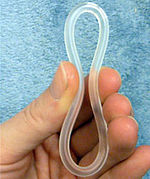| NuvaRing | |
|---|---|
 NuvaRing is a flexible plastic ring with both oestrogen and progesterone. | |
| Background | |
| Type | Hormonal |
| First use | 2001 |
| Failure rates (first year) | |
| Perfect use | 0.3 for Nuvaring% [1] |
| Typical use | 1.5 to 9 for Nuvaring% [2] [1] |
| Usage | |
| Duration effect | 4 weeks for Nuvaring, 3 months for progesterone only vaginal ring |
| User reminders | Inserted for 3 weeks and then removed for 7 days for Nuvaring |
| Clinic review | Annual |
| Advantages and disadvantages | |
| STI protection | No |
| Weight | No proven effect |
| Benefits | Easy insertion and removal |
A contraceptive vaginal ring is a type of hormonal insert that is placed in the vagina for the purpose of birth control. The rings themselves utilize a plastic polymer matrix that is inlaid or embedded with contraceptive drug. [3] This drug, often one or two hormones, is absorbed directly through the bloodstream through the cells that line the vaginal wall. [4] [5] Some vaginal rings contain both an estrogen and a progestin (brand names NuvaRing and Annovera), which are available in Europe and the United States. [6] [7] [8] [9] Other vaginal rings contain just progesterone (brand name Progering). [10] The progesterone-only ring is only available in Latin America, exclusively for postpartum breastfeeding parents. [9]
Contents
- Combined hormonal contraceptive vaginal ring
- Mechanism of action
- Dosing
- Administration
- Side effects
- Progesterone only vaginal ring
- Indications
- Mechanism of action 2
- Dosing 2
- Administration 2
- Side effects 2
- Advantages and disadvantages
- Advantages
- Disadvantages
- Contraindications
- References
The Progering is made of silicone-elastorone with an outer diameter of 58 mm and cross-sectional diameter of 8.4 mm. [10] Similarly, Annovera has an outer diameter of 56 mm and cross-sectional diameter of 8.4 mm. [7] In contrast, the Nuvaring has a diameter of 54 mm with a cross-sectional diameter that measures 4 mm. [6] The vaginal rings work as a long acting drug delivery system for varying indications, including prevention of pregnancy, improvement of dysmenorrhea and menorrhagia, lower risks of ovarian and endometrial cancers, and reduction of risk of cysts in the ovaries. [11] Although the vaginal rings do not provide protection for sexually transmitted diseases, the rings are being assessed as a possible drug delivery system for HIV prevention. [12]